Which singing bowl is right for you? In this post, we reveal the tips and tricks to finding the perfect singing bowl. We also reveal the difference between older and newer bowls, how to tell if a bowl is low or high quality, and the best places to shop for singing bowls. Let's get started!
Introduction
Choosing a singing bowl can be daunting given the vast array of different types and sizes of singing bowls available for purchase. Quality singing bowls can also be pricey, making this purchase an investment that buyers should not take lightly. If you are overwhelmed by the choices of singing bowls out there, you are in luck! We have written this guide to help you narrow your choices and find the best singing bowl for your specific needs and preferences.
In this article we discuss the following:
- What are singing bowls?
- What are the different types of singing bowls?
- Older versus newer
- High quality versus low quality
- Sound and feeling
- What can different singing bowls do?
- Where can you buy singing bowls?
What are Singing Bowls?
If you are looking to buy a singing bowl, it is likely you are familiar with what singing bowls are, what they do, and perhaps their history. Singing bowls, also called Tibetan or Himalayan singing bowls, are ancient bowls that produce sound and vibration when played with a mallet or striker. They are often linked with Buddhism or other spiritual practices.
Singing bowls are generally made from an alloy of various metals which include copper, silver, iron, tin, lead, or gold. At the end of the 20th century, pure crystal singing bowls became very popular.
Singing bowls range in shape, style, quality, tone, size, and more. There are many variations and characteristics that make singing bowls unique. However, this uniqueness can be a challenge when on the hunt for the perfect singing bowl for your collection. This article will take a look at the many different kinds of singing bowls so that you can make an informed choice when purchasing your very own bowl.
What are the Different Types of Singing Bowls?
There are many different kinds of singing bowls. In fact, some researchers have identified as many as 50 different styles of singing bowls. However, most singing bowl dealers narrow their shop offerings down to seven or eight basic styles. Authentic, antique singing bowls will be at least 100 years old, while others can be hundreds of years old. Generally speaking, older bowls can be distinguished by their shape, markings, metal thickness, as well as the tone produced. Crystal bowls are new age and not considered to be antique singing bowls, so we will discuss their characteristics last.
Although there are various styles of Himalayn singing bowls, most genuine singing bowls can be traced to Nepal, Tibet, Mongolia, and India. When comparing different styles of singing bowls, a range of over five octaves can be produced, from high to low tones. The sizes can also differ drastically. A large Jambati bowl will dwarf a small Manipuri and there are hundreds of differently sized bowls between them!
Thadobati

Thadobati singing bowls are characterized by high walls, straight sides, flat bottoms, with plain, undecorated lips. They can play up to five different octaves and respond well when being played by a mallet. Thadobati bowls are small or medium sized and can range in price from as little as $60 to $560 USD. Some ancient Thadobati bowls date back to at least the 15th century, making them the oldest bowl forms. Additionally, there are many different sub-styles of Thadobati bowls due to their decorative markings. Thadobati singing bowls are among the most popular bowls.
Jambati
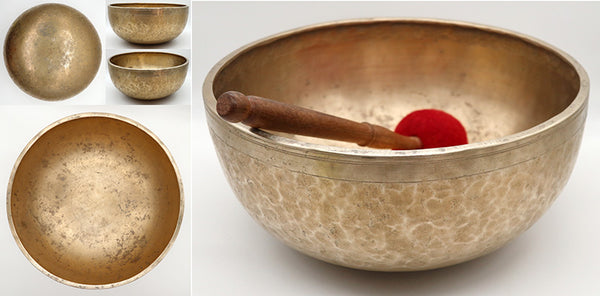
Photo Credit: Antique Singing Bowls
Jambati bowls have curved walls, flat bottoms, and lips that face inward. Their appearance is also notable due to their appealing hammer marks. They can play up to four different octaves but most generally play the 2nd or 3rd octave. They respond well when being played by a mallet. Jambati bowls are the largest and heaviest of all singing bowls. 3 to 4 craftsmen are required to forge a single Jambati bowl. Given their size and the labor required to make Jambati bowls, their prices range from $640 to $8,800 USD. These bowls are often found in great condition. Due to their size, they were often used for grain storage, which preserved them well. If you are interested in purchasing a Jambati bowl, you will also need to buy a mat or cushion to place it on while playing it. If you are planning on only owning one singing bowl, a Jambati bowl can be an excellent choice if your budget allows it.
Naga
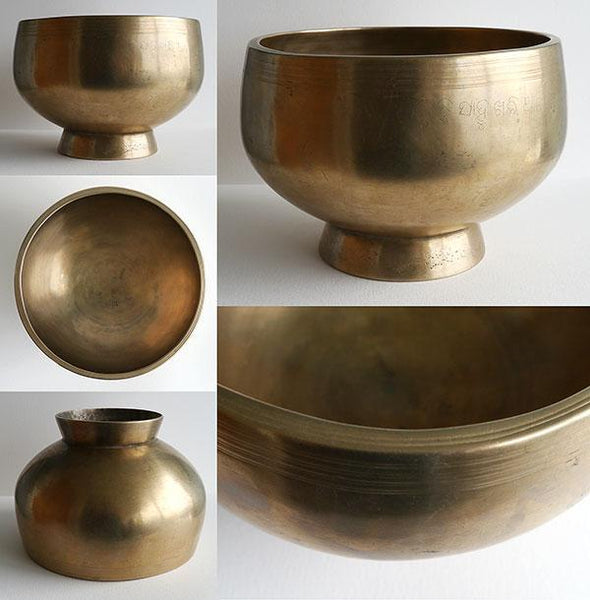
Photo Credit: Antique Singing Bowls
Naga singing bowls are also called Naga pedestal bowls. Its name is due to its chalice-like appearance. They are responsive bowls, but, unfortunately, their sound can sometimes be distorted by the pedestal base. They are small to medium sized bowls and considered to be very unique and rare. Antique Naga bowls are generally found in great condition, causing specialists to believe they must have served a ceremonial or sacred purpose. It is thought that its pedestal may perhaps have given it purpose as an offering bowl. Naga singing bowls range in price from $160 to $640 USD.
Mani
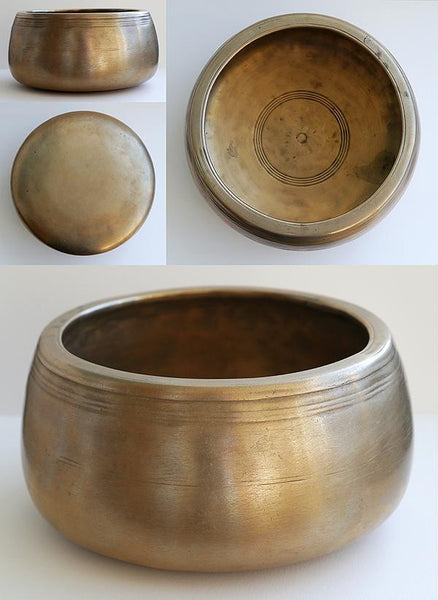
Photo Credit: Antique Singing Bowls
Mani bowls are short and stout with an inward-facing lip and flat bottom. They can play a range of three octaves and are considered mostly easy to play, however, some can be temperamental. Their tone is considerably higher than other bowls. Mani bowls are small to medium sized and can cost anywhere from $270 to $675 USD. Mani bowls are sometimes referred to as Mudra singing bowls and many might have been used for sacred, ritual or ceremonial purposes.
Ultabati
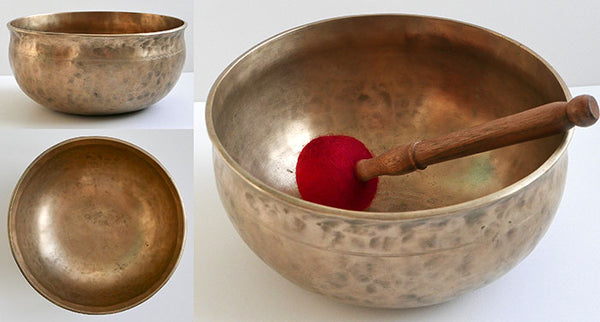
Photo Credit: Antique Singing Bowls
Ultabati, similar to Jambati bowls, are large, heavy bowls. They produce the lowest two octaves and can be very easy to play with practice. Ultabati bowls are capable of producing fountains as well as the OM sound favored in Buddhist practice. They are also some of the most expensive bowls, starting at $700 and going upwards towards $2,000 USD. Their appearance is also notable with darkened, or even black, outside walls. If you are planning on only owning one singing bowl, an Ultabati bowl can be an excellent choice if your budget allows it.
Manipuri

Photo Credit: Antique Singing Bowls
Manipuri singing bowls, which can be small or medium sized, have shallow insides and splayed rims. They produce a range of primary tones and are considered to be very affordable bowls, ranging in price from $75 to $425 USD. Given that they are easy to play and are financially accessible, Manupuri bowls are often the first singing bowls added to one’s collection.
Lingam
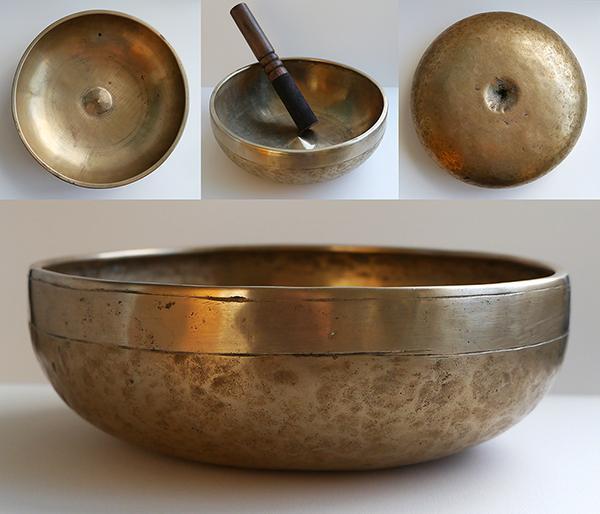
Photo Credit: Antique Singing Bowls
Lingam, or Lingham bowls, are shallow like Manipuri bowls but distinct due to the protrusion in the center of the bowl. The peak inside of the bowl creates a flat bottom with a navel-like indention. Their shape gives them a unique sound that can make them difficult to play. These small to medium sized bowls are extremely rare when authentic and can cost anywhere from $400 to $1,900 USD. However, be careful when looking for Lingam bowls. Some bowls can be reworked to appear like Lingam bowls but are, in reality, fakes.
Remuna
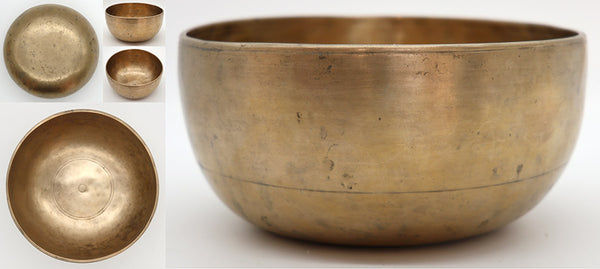
Photo Credit: Antique Singing Bowls
Rumana singing bowls are stout with smooth, thin walls. They are also known for their decorative artwork. These medium sized bowls are among the easiest to play and can cost anywhere from $235 to $635 USD.
Crystal
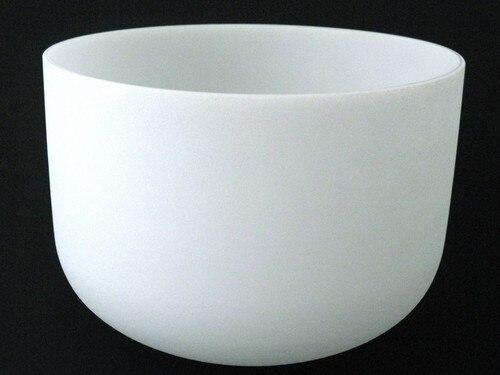
Crystal bowls were popularized in the late 1980s and early 1990s. Quartz crystal singing bowls can be frosted, clear, mineral fusion, or a handle bowl. Crystal bowls come in a variety of sizes and can produce a variety of tones, playing in the 3rd, 4th, and 5th octaves. Frosted bowls generally produce the loudest sounds. Clear bowls are not as loud, but give off clear tones. Handle bowls are louder and easy to play.
Older Versus Newer Singing Bowls
There are both advantages and disadvantages to older and newer singing bowls. Ancient Tibetan bowls, like any antique, must be authenticated for their age and quality. Many of the newer bowls being produced today are made to look old, but old bowls will stand out from the new bowls in both appearance and tone.
Older bowls generally have thinner layers of metal on the bottom than newer bowls. However, do not let the signs of aging and wear scare you away. These bowls are at least 100 years old and these signs of wear are not only to be expected but appreciated. Older bowls also have richer, warmer tones than newer bowls, which have more metallic and sharp tones. Newer bowls, on the other hand, will stand out when struck as the vibration of newer bowls is more powerful and will ring out longer.
The most popular ancient singing bowls in the West are Thadobati, Manipuri, and Jambati singing bowls. Price is also a considerable difference between authentic, ancient bowls and new, machine manufactured bowls. Antique bowls will be a lot more expensive than new bowls. Antique bowls are investments, whereas new bowls can be affordable options for beginners.
High Quality Versus Low Quality Singing Bowls
In order to differentiate between high quality and low quality singing bowls, you must be able to play the bowl or at least hear a sound clip. A high quality bowl will be able to hold its vibration and produce several tones, harmonics and overtones. If the vibration sounds as if it’s “fluttering” away, the bowl is not high quality.
You should be aware that the amount of time or effort it takes to make the bowl sing is not important. One might assume that a bowl that sings right away indicates that it is a good bowl, but whether it sings right away or needs to be played for a while is unimportant when determining a bowl’s quality.
Lastly, a high quality bowl will be one made from the finest metals, which will ensure durability and longevity.
Sound and Feeling of Singing Bowls
Although there are many things to consider before purchasing a singing bowl, sound should be of the utmost importance. It is important to choose a singing bowl with an excellent voice--one that moves you and makes you feel something.
When listening to a bowl, observe how the sound affects your body. Do you feel moved? Are there any tingling sensations in any area of your body? You should be able to feel the vibrations and tones produced by your singing bowl and they should feel good upon receiving them.
In addition to how the sound makes you feel, is the singing bowl a good physical fit for you? Is it too heavy? Is it too small? Is it too big to hold? Will the weight be a problem when playing for long periods of time?
Generally speaking, bowls weighing more than 3 pounds, or 1.5 kilos, may become difficult to hold when playing for long periods of time. On the other hand, very light bowls can be moved too easily while being played leading to distorted sounds or worse, as they are liable to falling over and cracking. You should look for a singing bowl that is as close to your perfect fit as possible!
What Can Different Singing Bowls Do?
Different styles of singing bowls can have different purposes and uses. Therefore, when looking for a singing bowl to purchase, make sure to ask yourself how you plan to use the singing bowl. Is it for meditation? Grounding? Physical healing? Sound therapy? Yoga classes? Chakra healing? Singing bowls can make great additions for all of these uses but specific bowls might work best in specific cases.
When using singing bowls for meditation, bowls that produce low tones or even the OM sound are best. Ultabati and Jamabati bowls are known for their deep, lasting sounds and are great for meditation. However, if you are meditating in a small room, a smaller bowl, such as the Thadobati, Mani, or Manipuri bowls might be best.
Similar to meditation singing bowls, the singing bowls that work best in yoga classes are the ones that produce low tones. If your yoga classes move location, smaller bowls provide greater portability. Grounding practice requires singing bowls that can produce lower tones, as well, like the Ultabati and Jamabati bowls.
Singing bowls that are useful in physical healing include extremely high pitched bowls, which can help drive out illnesses in the body. A Mani bowl, which is known for its higher pitched tone, could make a great bowl for physical healing.
Various singing bowls can be used for sound therapy. Choosing a bowl depends on how you plan to use the bowl and what ailments you are trying to remedy. Size, for example, can be an important factor. Larger bowls should be placed near the feet and smaller bowls with warm tones near the head. Crystal handle bowls can also be useful in sound therapy as the handle allows you to move the bowl across the patient’s body. Naga singing bowls are also linked to sound therapists and healers.
Singing bowls, specifically crystal singing bowls, are often associated with chakra healing. Some specialists believe that specific tones work for specific chakras. For example, smaller, higher pitched bowls work best for the third eye. However, some experts stress that regardless of the specific pitches and chakras, what is most important is the “quality of your own intention and awareness” when using singing bowls for chakras.
Where Can You Buy Singing Bowls?
You can buy singing bowls in a variety of different places. There may be health and wellness stores in your area which have singing bowls for sale from time to time. In addition, there are great places to purchase singing bowls online. In particular, you should consider purchasing a singing bowl from Shanti Bowl, which was founded in 2015 to spread awareness of the beauty and health benefits of singing bowls. These bowls, which are of the highest quality, are intentionally priced well below their market value in order to ensure they are accessible to the most people possible. In addition, Shanti Bowl donates significant proceeds to non-profit organizations that work to provide meditation and mindfulness practices to at-risk communities.
Takeaway
Singing bowls can make a great addition to your therapy and health practices, to your daily meditation routine, or to your group yoga classes. Singing bowls and their healing properties, including stress reduction and pain elimination, can improve our overall well-being. In order to purchase the best singing bowl to improve your life, be sure to narrow down your preferences of style, shape, size, sound, quality, and price. Ultimately, you should choose a bowl that both meets your needs and creates love and harmony within you upon hearing its special voice.
We invite you to get your own Tibetan singing bowl or crystal singing bowl today!
Did You Enjoy This Article?
Thank you for reading! If you enjoyed this article, you might also like the following articles: Singing Bowls for Beginners: The Complete Guide and Best Tibetan Singing Bowl Music

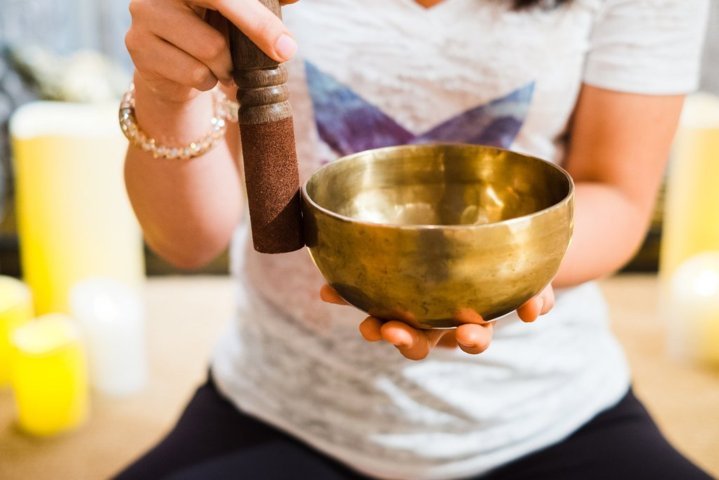
18 comments
Mar 20, 2025 • Posted by Shanti Bowl
Hi Nicole, thanks for your question! We would recommend starting with our 5.5" Tibetan singing bowl: https://www.shantibowl.com/collections/all-products/products/tibetan-singing-bowl
Mar 20, 2025 • Posted by Nicole
I’m wondering which type & size bowl might be best for someone with scoliosis?
Mar 21, 2022 • Posted by Shanti Bowl
Hi Dolly, thanks for your question! We think our classic 5’5 Tibetan singing bowl would be a perfect option for your purposes. Please click the “shop” button in the menu on this site to see our products!
Mar 21, 2022 • Posted by Dolly
I have a large heavy singing brass bowl and live the sound. However i am starting to work as an end of life doula and need somthi g smaller. Usually, the smaller, the highee pit h, so i am wondering what would be good for those dying that would like sound therapy?
Dec 23, 2021 • Posted by Shanti Bowl
Hi Stephanie, thanks for your comment! What an interesting story! It is hard to know what to make of the story, as we have heard of some unscrupulous store owners pretending not to be able to make a bowl sing in order to make a customer feel as though it is the one for them when they are able to play it. Maybe bring a friend to the store and see if they can play it? Good luck!
Dec 23, 2021 • Posted by Stephanie Hart
I had never known what a sighing bowl was until I visited Arizona and saw one in a shop. I feel like it immediately called me and the person working there said she’s been playing with them but the bowl I fell in love with he couldn’t make it sing. I picked it up and it sang beautiful for me. Could I be imagining that?
Aug 30, 2021 • Posted by Shanti Bowl
Hi Raj, thanks so much for your question! For a great singing bowl that helps balance all of your chakras, check out out 5’5 and 8 inch singing bowls. You can browse them by clicking the “shop” menu at the top of this page. Please let us know if you have any more questions!
Aug 30, 2021 • Posted by Raj Kumar
Is it Possible to use one Big Singing Bowl for All Chakras improvement??
Aug 20, 2021 • Posted by Shanti Bowl
Hi Ramchandra, thanks for your question! We offer some great singing bowls which would be perfect for your needs. Just click the “shop” button on the menu at the top of the page to view our selection, and please let us know if you have any questions!
Aug 20, 2021 • Posted by Shanti Bowl
Hi Steve, thanks so much for your question! We offer some great singing bowls which would be perfect for your needs. Just click the “shop” button on the menu at the top of the page to view our selection, and please let us know if you have any questions!
Leave a comment